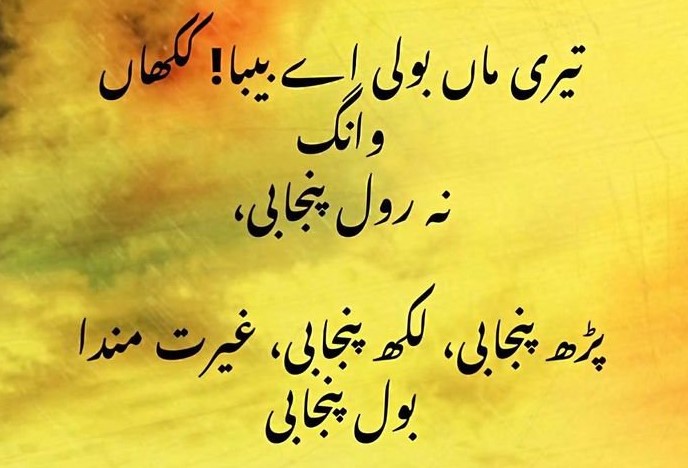How to save a language: Punjabi in Pakistan

Recently, I wrote a post on this website about how Punjabi language is on the path of slow extinction in Pakistan. The article highlighted a range of causes at individual, domestic and institutional level, as a result of which, a major chunk of Punjabi youth – particularly in the urban centres – are unable to speak the language. The stigma and embarrassment attached to Punjabi are causing the erasure of not just the language, but also the rich history and culture linked to it.
Read: How to kill a language: Punjabi in Pakistan
It would be unfair to write on the issues and not try to propose solutions. This article is a meagre attempt to address a highly complex problem and make and effort to start a conversation that might lead to a tangible result in the future. We will divide the actions that can be taken in order to preserve Punjabi into four levels: individual, domestic, institutional/state-level, mass media/personalities.
1) Individual Level
A society is made up of individuals, each of one contributes in social phenomena in their limited capacity. Languages die when individuals stop speaking them. Simple. The silver lining in the situation with Punjabi is that millions still speak it in Pakistan. At an individual level, it is important for those of us who are grown up adults, to make an effort to learn the language. To the ones who know it, they have the responsibility to teach it to as many individuals as they can.
It is even more important for females to learn and use the language. The tragedy is that most men learn it at some point in their lives due to their increased public exposure, but women rarely get that opportunity. Unless women resume speaking the language, it will not be used in households, which takes us to our next level of language preservation.
2) Domestic/Household Level
Family is the ultimate deciding factor of what shape the society will take moving forward. The tragedy with Punjabi is that it suddenly stopped being the medium of communication in many families. This was essentially driven by two reasons: 1) Parents wanted their children to shift to the ‘elite’ languages i.e Urdu and English and Punjabi became associated with the ‘lower class’, and 2) Mothers did not know Punjabi hence the general language in use in the house moved from Punjabi to Urdu.
For me personally, Punjabi has never been spoken in my house because my mother doesn’t know how to speak it. She never learnt it because her parents thought it was better for her to learn Urdu as it was used in the educational institutes and professional life. My father speaks to all his relatives in Punjabi, but doesn’t use it at home. As a result, me and my siblings cannot speak Punjabi. It is a generational cycle that ultimately leads to the loss of a language. Unless it is broken and Punjabi is brought back to the households, we cannot hope of preserving it.
3) Institution / State Level
I mentioned in the previous post about how using Punjabi as a means of communication in educational institutes is banned in Pakistan, along with other state level restrictions on the use of the language. It is unfortunate that rather than playing an active role in the preservation of the language, the state is quickening the pace of its death.
After households, schools play the most crucial role in laying an individual’s intellectual and linguistic foundations. Punjabi can still be saved by passing it on to the next generation through schools, even if families fail to build that base. It is about time that the Punjab government actively patronises the individuals/organisations working for the language’s preservation, and make efforts to pass it on to the next generations. Not only should the ban on Punjabi as a means of communication in educational institutes be lifted, but there should also be government support towards publication of Punjabi literature and promotion of Punjabi art.
4) Mass Media and Celebrities
Pakistanis as a nation are highly influenced by trends on mass media and what they see their favourite celebrities – media and sports personalities primarily – follow. As mentioned in the previous part of this series, it is unfortunate that in recent times, the portrayal of Punjabi has been reduced only for comic relief purposes. There are only few instances like Geo Entertainment’s Ramadan shows Ishq Jalebi and Chaudhry and Sons, or Kashif Nisar’s on going Jeevan Nagar on Green Entertainment, where Punjabi language is shown as a fundamental aspect of human lives. The characters use it to express their sincerest emotions, not just humor.
It is about time that we see more holistic portrayal of the Punjabi on our screens because reducing it solely to humor is a disservice to the language. Celebrities belonging to Punjab will have to play an active role in mainstreaming the use of the language and breaking the taboo and embarrassment surrounding the language. Compared to celebrities belonging to other regions, Punjabi celebrities have a greater responsibility because this is the only language that is taking a backseat. Other languages are still actively being spoken without shame.
Conclusion
This article aimed to provide a very simplistic roadmap to a very complex problem. The removal of Punjabi from the mainstream is the result of the interplay of numerous social, political and historical factors. No single solution can put an end to this problem. However, no matter how complex the issue appears to be, it is still not beyond salvation. With targeted and collaborative efforts of different members of the society, in their own scope of work, we can prevent the demise of Punjabi entirely.
The author is a Management Sciences graduate from Lahore University of Management Sciences (LUMS) and an aspiring civil servant with a knack for writing.
